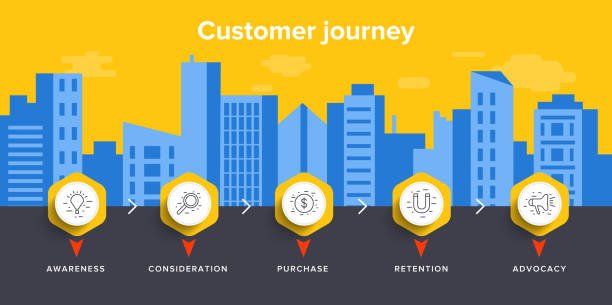Navigating the intricate pathway that consumers traverse from initial awareness to conversion is a fundamental aspect of marketing analytics. Recognizing the diverse touchpoints and stages within the customer journey is pivotal for businesses to formulate more effective marketing strategies, prioritize high-impact touchpoints, and amplify customer engagement. This comprehensive guide delves into the world of customer journey mapping, shedding light on its crucial role in contemporary marketing.
What is Customer Journey Mapping?
Customer journey mapping is a systematic approach designed to comprehend every interaction a customer has with a brand across various touchpoints. It serves as a visual representation, offering a clear depiction of the customer’s experience, spanning from the first spark of awareness to post-purchase interactions.
Key Components of Customer Journey Mapping:
1. Touchpoints and Channels:
Identifying every point of interaction, whether digital or physical, is crucial. This includes online advertisements, customer service calls, and in-store visits, ensuring a holistic perspective.
2. Stages of the Journey:
Segmenting the customer’s journey into stages like awareness, consideration, purchase, retention, and advocacy allows for precise interventions at each phase, catering to specific needs and behaviors.
3. Emotional Insights:
Beyond actions, the customer journey map captures the emotions and attitudes at each touchpoint. Understanding the reasons behind behaviors provides valuable insights for refining marketing strategies.
4. Pain Points and Opportunities:
Pinpointing areas where customers may face challenges or barriers is critical. Addressing these pain points not only improves the customer experience but also reveals opportunities for further engagement or service enhancement.
5. Decision-making Factors:
Identifying the factors driving customer choices, be it product reviews, peer feedback, or detailed information, is essential. This knowledge informs content and promotional strategies.
Why Customer Journey Mapping Matters?
Understanding customers’ interactions with a brand is foundational for success. A customer journey map:
1. Understands Customer Needs and Wants:
Provides insights into what customers think, feel, and do at each interaction, aiding in tailoring products, services, and support for a better customer experience.
2. Enhances Customer Experience:
Sheds light on areas of friction, allowing businesses to address pain points, increase conversions, and create a seamless, personalized experience.
3. Optimizes Marketing Efforts:
By identifying influential stages, marketing teams can tailor campaigns to maximize engagement, ensuring the right message reaches customers at the right time.
4. Enhances Communication Among Teams:
Creates a shared understanding among departments, improving teamwork, aligning everyone toward common goals, and ensuring cohesive customer experiences.
5. Increases Revenue Opportunities:
Reveals untapped opportunities for growth, whether it’s a market gap, potential upsell, or new engagement avenues, driving revenue.
Types of Customer Journey Maps:
Customer journey mapping is versatile, with various types catering to different goals:
1. Current State Maps:
Offer a snapshot of the current journey, highlighting pain points and the effectiveness of current strategies.
2. Future State Maps:
Look forward, to guiding brands in reshaping strategies and innovating touchpoints for an optimal customer experience.
3. Service Blueprint:
Delve into operational aspects, aligning internal processes with customer needs for a consistent and efficient experience.
4. Touchpoint-Specific Maps:
Focus on individual interactions to refine specific stages of the journey, ensuring alignment with the overall brand promise.
5. Persona-Based Maps:
Tailored to represent the journey of specific user personas, considering unique needs, preferences, and challenges.
8 Stages in a Customer Journey:
A customer journey typically consists of eight essential stages, each playing a unique role in a consumer’s interaction with a brand:
Awareness:
- Where potential customers first encounter a brand or its offerings.
Interest:
- Customers actively seek more information, diving deeper into what the brand offers
Consideration:
- Customers weigh the brand’s offerings against competitors, looking for what sets it apart.
Intent:
- Decision-making phase, where potential clients are ready to make a decision.
Purchase:
- The stage where intent transforms into action.
Use:
- Customers interact with the product or service, shaping their experience.
Loyalty:
- Consistent positive interactions lead to customers viewing the brand as their preferred choice.
Advocacy:
- Satisfied customers actively promote the brand, sharing positive experiences with peers.
How to Do Customer Journey Mapping?
1. Define Customer Personas:
Purpose:
Creating detailed customer personas is the foundational step in understanding your audience. Personas represent fictional characters that embody the characteristics of your target customers. This helps in tailoring your customer journey map to specific needs and preferences.
Process:
- Research and Segmentation: Conduct market research to identify different customer segments. Group customers based on demographics, behaviors, and preferences.
- Persona Creation: Develop detailed personas for each segment. Include information such as age, gender, job role, interests, pain points, and goals. Give each persona a name and a face to make them more relatable.
- Mapping to Customer Journey: Align each persona with different stages of the customer journey. Consider how each persona’s needs and behaviors may vary at various touchpoints.
2. Identify Touchpoints:
Purpose:
Pinpointing every interaction a customer has with your brand allows for a comprehensive understanding of their journey. Touchpoints include both digital and physical interactions, providing a holistic view of customer engagement.
Process:
- Customer Journey Mapping Workshop: Gather cross-functional teams to brainstorm and identify touchpoints. Include representatives from marketing, sales, customer service, and other relevant departments.
- Digital Touchpoints: List all online interactions such as website visits, social media engagement, email communications, and online purchases.
- Physical Touchpoints: Include offline interactions like in-store visits, phone calls, and physical product interactions. Consider events, packaging, and any other tangible elements.
3. Gather Data:
Purpose:
Utilizing customer feedback, surveys, and analytics tools is crucial for acquiring both qualitative and quantitative data. This step helps in obtaining a well-rounded understanding of customer behaviors, preferences, and pain points.
Process:
- Customer Surveys: Create surveys to gather direct feedback from customers. Ask about their experiences at different touchpoints and their overall satisfaction.
- Analytics Tools: Utilize web analytics tools to track online customer behavior. Understand how customers navigate your website, what pages they visit, and where they drop off.
- Social Listening: Monitor social media platforms for mentions and comments related to your brand. Identify trends and sentiments expressed by customers.
4. Create the Map:
Purpose:
Developing a visual representation of the customer journey consolidates the gathered data and insights. This map should highlight key touchpoints, emotions, and pain points, providing a clear roadmap for understanding and improvement.
Process:
- Select a Framework: Choose a customer journey mapping framework that aligns with your business goals. Common frameworks include linear, cyclical, or experience-focused models.
- Visual Elements: Incorporate visual elements such as timelines, graphs, or charts to represent the customer journey. Use colors and icons to emphasize emotions, pain points, and positive experiences.
- Collaborative Creation: Involve key stakeholders in the creation process to ensure diverse perspectives are considered. Encourage input from teams who directly interact with customers.
- Update and Iterate: Regularly update the customer journey map based on new data and feedback. The customer journey is dynamic, and continuous improvement is key.
Customer Journey Optimization:
1. Continuous Analysis:
Purpose:
Continuous analysis involves regularly reviewing and updating the customer journey map to adapt strategies based on evolving customer behaviors and preferences.
Process:
- Regular Audits: Schedule regular audits of the customer journey map. This could be monthly, quarterly, or as needed based on the pace of changes in your industry.
- Feedback Loop: Establish a feedback loop to collect insights from various customer-facing teams. Insights from customer service, sales, and marketing teams can provide valuable information.
- Data Analytics: Leverage data analytics tools to monitor and analyze customer interactions. Identify patterns, trends, and potential areas for improvement.
- Adaptive Strategies: Based on the analysis, adapt marketing strategies, communication approaches, and touchpoints to better align with customer expectations and market trends.
2. Integrated Technologies:
Purpose:
Embracing integrated technologies ensures a seamless and efficient customer journey by utilizing tools like CRM systems and marketing automation.
Process:
- CRM Systems: Implement Customer Relationship Management (CRM) systems to centralize customer data. This allows for a holistic view of customer interactions across various touchpoints.
- Marketing Automation: Utilize marketing automation tools to streamline and personalize customer interactions. Automation can be applied to email marketing, social media, and other communication channels.
- Unified Customer Profiles: Integrate data from various channels to create unified customer profiles. This helps in providing a consistent experience as customers transition between different touchpoints.
- Real-time Data Sharing: Ensure that data is shared in real-time across different teams and systems. This enables prompt responses and a synchronized approach to customer engagement.
3. Cross-Channel Consistency:
Purpose:
Maintaining a consistent brand image across all touchpoints is essential for providing a cohesive experience to customers, whether they are interacting online or offline.
Process:
- Brand Guidelines: Establish and adhere to brand guidelines that dictate the visual and tonal aspects of communication. This ensures a consistent brand image.
- Omnichannel Strategy: Develop an omnichannel strategy that unifies the customer experience across all channels. Whether a customer interacts through social media, the website, or in-store, the experience should be cohesive.
- Employee Training: Train employees across different departments to deliver a consistent brand message. This includes sales representatives, customer service agents, and anyone who interacts with customers.
- Feedback Mechanisms: Implement mechanisms to gather feedback on cross-channel experiences. Identify any discrepancies or areas where consistency can be improved.




